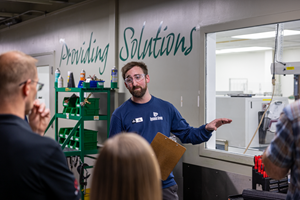Cell Automates Overmolding, Inspection of Hypodermic Needles
Moldworx designed a mold, end-of-arm-tooling and automation cell to automate production of hypodermic needles, replacing manual post-mold gluing.
Asked by a medical OEM to develop a single-cavity injection mold to overmold a needle that was being manually glued in place, Moldworx LLC, a custom molder/moldmaker based in Gilbert, Ariz., did one better—or technically four better—developing a fully automated four-cavity tool and cell that runs on a horizontal press. The company initially proved out the concept on a single-cavity tool featuring slides where the needle was hand loaded. Jim Taylor, Moldworx president, told Plastics Technology that the new four-cavity automated cell runs on a 27-second cycle, matching the time used by the single-cavity tool but quadrupling the output. Before Moldworx developed the cell, the customer had three shifts of people gluing needles in place.
Taylor said that to shorten the lead time, Moldworx designed and built the entire automation cell in parallel with the mold. One challenge Moldworx had to overcome was singulating thousands of delicate, tiny needles—as small as 0.012 inch (0.305 mm)—that are bulk-packed. Moldworx ultimately designed and developed a “singulator” with a “hopper” that would introduce one needle at a time to the assembly line cell.
Each needle is picked up by a robot affixed to the injection molding machine and indexed in front of a set of high resolution inspection cameras to ensure it is not bent or that the needle tip is not damaged. The needles also must be oriented correctly, as there is a sharp end and a blunt end. Taylor said the system will discard the needle if the blunt end is up, trying this three times before alarming.
The needle is then placed into the tool for overmolding. Using gravity and a vertical press can often ease insert overmolding, but Moldworx designed this system to run on a horizontal press. To hold the needle in place prior to injection, Taylor said the tool features a slide with a core pin that has a .013Ø hole in it to accept the needle. The slide/core pin act as guides to allow the assembly to move away from the parting line and provide easier access to load the needle.
The process starts when the custom designed end of arm tool (EOAT), which is affixed to a 3-axis Yushin Robot, docks at the needle pick-up location and transfers the needle to the mold, docking with the tool to ensure precise positioning. In its first action, the EOAT grips the finished part and retracts to move it out of the way.
Once a sensor verifies the EOAT has the part, it moves towards the slide and engages with the guide pins. At this point, the gripper with the needle is just above the slide core pin. A servo cylinder on the slide moves the core pin up to allow the needle to move into the hole; the servo moves to the finished install position; and the EOAT reverses its sequence. A laser installed in the mold verifies the needle is present before the molding cycle begins.
When the mold opens, the robot removes the molded assembly and places a newly inspected needle into the mold. Moldworx noted that all these actions require inspection and verification, and tolerances must be exact.
After molding, the end of arm brings the finished, molded assembly to the off-load position in the assembly cell, according to Taylor, placing the molded part on a mandrel before leaving to get another needle. At this station, two cameras verify the sharp end is up; the tip is not damaged; and the needle is not bent. If the needle passes inspection, the table indexes to the next position where filtered, metered air is pushed thru the needle to check for occlusion.Related Content
Medical Molder, Moldmaker Embraces Continuous Improvement
True to the adjective in its name, Dynamic Group has been characterized by constant change, activity and progress over its nearly five decades as a medical molder and moldmaker.
Read More3D Printed Spine Implants Made From PEEK Now in Production
Medical device manufacturer Curiteva is producing two families of spinal implants using a proprietary process for 3D printing porous polyether ether ketone (PEEK).
Read MoreMedical Manufacturer Innovates with Additive Manufacturing and Extrusion Technology Hubs
Spectrum Plastics Group offers customers two technology hubs — one for extrusion, the other for additive manufacturing — to help bring ground-breaking products to market faster.
Read MoreKrones Acquires Netstal
Krones adds PET preform injection molding to its bottle blowing and filling capabilities, as well as cap molding and expansion into medical, food and other markets.
Read MoreRead Next
Lead the Conversation, Change the Conversation
Coverage of single-use plastics can be both misleading and demoralizing. Here are 10 tips for changing the perception of the plastics industry at your company and in your community.
Read MorePeople 4.0 – How to Get Buy-In from Your Staff for Industry 4.0 Systems
Implementing a production monitoring system as the foundation of a ‘smart factory’ is about integrating people with new technology as much as it is about integrating machines and computers. Here are tips from a company that has gone through the process.
Read MoreFor PLASTICS' CEO Seaholm, NPE to Shine Light on Sustainability Successes
With advocacy, communication and sustainability as three main pillars, Seaholm leads a trade association to NPE that ‘is more active today than we have ever been.’
Read More

























